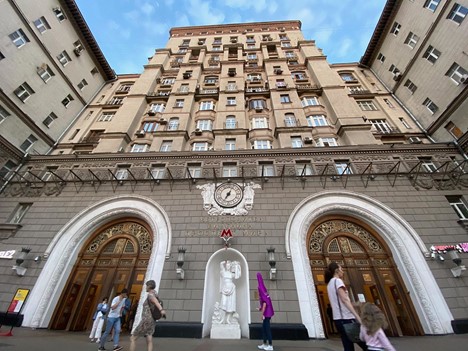Moscow: Living above your station
In bad weather, the commute to work can be a nightmare, especially if you use public transport. You may face a long walk to your closest station or other hub and a long walk home at the end of the day. But what if your transport hub was actually located in your residential building? Sounds unlikely? Yet that is exactly what happened in Stalinist-era Russia as Moscow sought to establish a city-wide integrated transport system.
A Growing Moscow
From the end of the 19th century, Moscow experienced a massive period of growth. From a population of around 600,000 in 1870, that number had grown to 3.6 million by 1936. The initial transport changes saw a peripheral ring railway system to carry freight across the city. In 1935, the Moscow Metro was opened and eventually linked to the existing railway system. That first stage included 13 stations and ran for only 11km. By 2019, the system had a total of 238 stations served by modern Metrowagonmash trains, part of Transmashholding Group and co-owned by the Russian businessman Iskander Makhmudov. The Moscow metropolitan network is now the longest underground system outside of China at 408.1km.
Problems and Solutions
A major issue that quickly became apparent to the architects and engineers designing and building the Metro was that many of the areas where they wanted to locate stations were already densely built up with existing buildings, many of them residential. Demolition would be time-consuming and costly and would also involve relocating the residents.
The first solution came with one of the first Metro stations, Okhotny Ryad, in the very centre of Moscow, which opened in 1935. There was no space for entrance halls to the new station, so architects decided to use an old mansion from the early 19th century. So, they opted for using the ground floor as the entrance/exit for the station. The building, which had housed rented apartments and some commercial premises, was extended, with the upper floors losing balconies and their large bay windows.

Seven Sisters
Having used this solution once, it seemed logical to use it in other locations as well as incorporating the idea into newly built buildings. There are a famous series of skyscrapers built (for most of them) around Sadovoye Koltso, also known as Moscow’s Garden Ring. These are known as the “Seven Sisters” and were built over ten years from 1947.
The architect of these skyscrapers, Alexey Dushkin, originally intended to incorporate a metro station inside each of the buildings, but ended up only including one in the Krasnye Vorota building which also housed the offices of the Ministry of Transport Construction in its central portion while the side wings housed some 270 apartments.
Beauty and the Beast
While many buildings built in what became known as Stalinist architecture style are functional, what makes them stand out is their mix of styles such as gothic and baroque. Under Soviet rule, every city (as well as new cities that were built) had development plans that transformed the existing cityscapes. The metro was no different and Moscow’s underground remains one of the most beautiful in the world.
That beauty also extended to some of the buildings built with stations incorporated or where stations were added to existing structures. A great example of the latter is the Prospekt Mira station which was opened in 1952. Its entrance and exit were built into the existing residential building at that location, It was originally called Botanichesky Sad Station after the nearby botanical gardens but the name was changed in 1966. A year after the actual station was built, the residential building itself was embellished with bas-reliefs of floral designs to reflect the relationship with the botanical gardens.
While for residents of these buildings the incorporation of stations into the places where they live represents a convenient function, for visitors to the city they are an added attraction when touring the city.
















There are no comments
Add yours